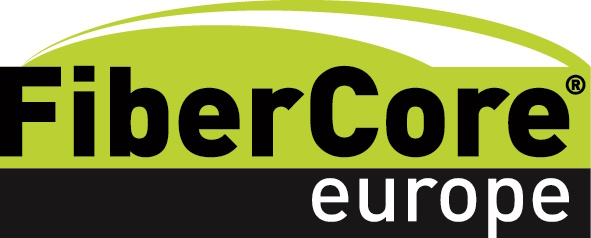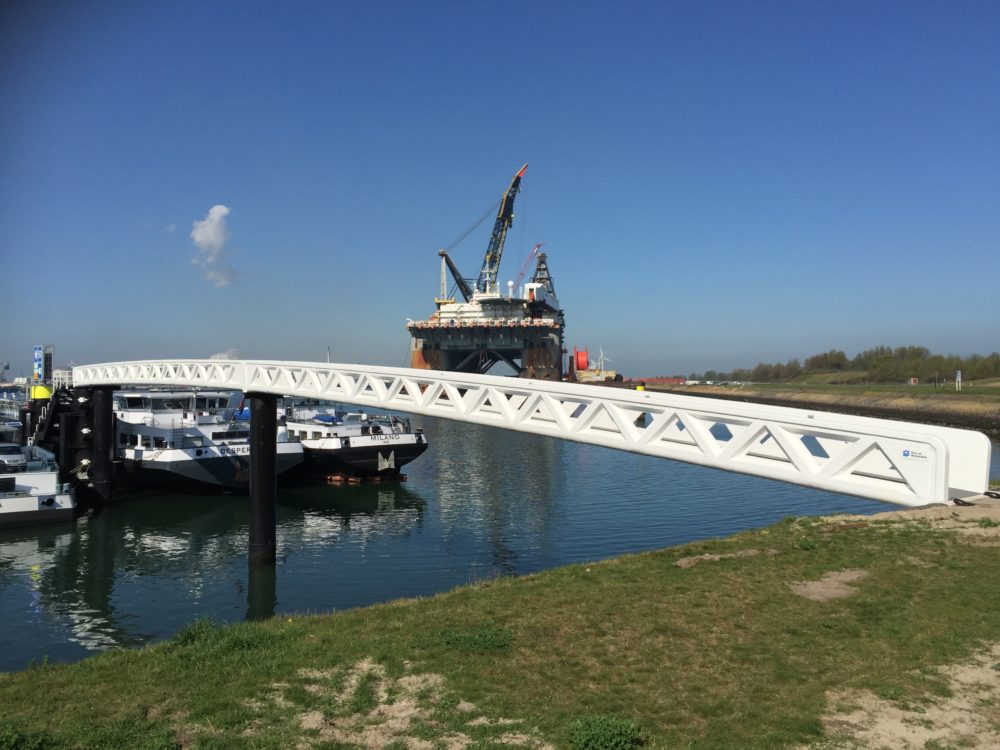Port of Rotterdam and FiberCore Europe join forces for a more sustainable society
The Port of Rotterdam Authority has great social ambitions. It wants to be an international leader in sustainability. Improvements in the port's infrastructure are therefore constantly dominated by innovative solutions that must be both sustainable and efficient. One particular example is the port bridges for inland shipping. FiberCore Europe has now realized twenty-four of these footbridges in environmentally friendly plastic composite in the port area.
Project manager Matthijs Tromp (33) has been working closely with FiberCore in the development of these bridges in the Europoort region since he joined the port authority five years ago. Twelve more will be installed in the Calandkanaal-West this year. "By doing this, we show that the Port Authority is serious about sustainable innovations," says Tromp. "In this way, we also want to make other companies enthusiastic about doing the same. This project contributes to the energy transition because the product has a beneficial impact on reducing CO2."
The main function of harbor bridges is to connect the ship's berth to the shore. The users are mainly skippers, crew and family members. But they are also used by mechanics, suppliers and "surveyors" who check ship cargo for quality. The bridges provide shore power so that ships can (sometimes have to) turn off generators. The Port Authority has also constructed bridges for the patrol vessels' own unloading locations. A fiber optic cable and drinking water line run through the bridge there to the pontoon to provide a workstation and to bunker the patrol vessels with fresh drinking water.
Fiber reinforced plastic
FiberCore specializes in load-bearing structures made of fiber-reinforced plastic (composite). The worldwide patented InfraCore® technology underlies this and is used in (traffic) bridges, bridge decks and lock gates. Based on this technology, large white mats of coarsely woven glass wires are used in a special way as reinforcement in a mold that is pulled under vacuum. The glass fabric is then injected with resin (the "cement"). After curing, the result is a remarkably strong flat sheet that can be heavily loaded. Even the deck of an oil rig could be fitted with it. Composite has become an attractive construction material alongside concrete and steel. It is light, maintenance-free, environmentally friendly and is expected to last a hundred years.
At the time, the Port of Rotterdam Authority was not insensitive to the positive properties of the product. But those who have been familiar for years with steel bridges and standards in the field of infrastructure projects in the port area would not immediately want to change course and go into business with the relatively new plastic composite. "We had to think about that for a while," Tromp smiles. "My colleague, project engineer Age Buitenrust Hettema, got me excited about FiberCore's solution. He supervised the development of the first footbridge in the Hartel Canal."
Technically perfect
This bridge, installed in December 2012, consists of two parts with visible innovations compared to steel bridges: piping systems and LED lighting are integrated as well as the snow-white color stands out, making the bridge highly visible to boaters. Technically perfectly executed, but the construction costs were higher than everyone had counted on and the lead time was too long. Tromp: "That was mainly due to wrongly chosen starting points. The most important lesson we learned is that the function of the bridge should be leading, not the design and styling we assumed." Working with FiberCore, the Port Authority then conducted a feasibility study with the goal of making the bridge's life cycle cost competitive with steel. "Ambitious, but now it became very clear that substantial savings had to be made on all components, such as production method, residual materials and man-hours. And we succeeded with the bridges that were subsequently developed. Of course, this was done in a team with different disciplines. In addition to engineers, superintendents, planners and cost experts, there were also many external stakeholders, such as engineering firms and contractors. I am proud that together we had the patience for it and achieved this," says Tromp.
Nice results
The low-maintenance concept and long life were important arguments for the Port Authority to proceed with the development of the walkways. The passion of FiberCore employees Jan Peeters and Simon de Jong, founders of the company, also accelerated everything. Trump is adamant: "They convinced us that this alternative solution could lead to great results. When the results of the Life Cycle Cost analyses (purchase, maintenance and disposal) turned out to be comparable to those of steel walkways, we were confident and started. By the way, we don't just weigh investment and maintenance costs. Factors such as availability, reliability, risk and safety are at least as important to us."
The Port Authority knew that in the harsh and salty climate of the Port of Rotterdam, maintenance costs for steel bridges can add up significantly over the years. Steel must be preserved every 10 to 15 years to prevent corrosion. Moreover, this cannot be done on site. The steel bridge must be picked up and transported to a specialized maintenance company. Even then, such a bridge is written off after forty years. Plastic composite is low maintenance and has the prospect of a life span of at least one hundred years. In addition, the composite version is impervious to chemicals and glass fibers are as much as ten times stronger than steel.
The feasibility study showed that composite bridge decks of 32 meters were possible. For the discharge locations in Pistoolhaven (Europoort) and Madroelhaven (Pernis), it was not possible to drive support piles because of risks with unexploded World War II explosives. "In Madroelhaven, we wanted to avoid high research costs for detection of these. By not building the bridge out of standard two times 19 meters, but by bridging 32 meters to the pontoon in one go, without support pile, that cost was out of the picture. In steel, such a bridge would have been too heavy to land on a pontoon."
In the Pistol Harbor, another challenge played a role. There, the slope was very steep and fully lined. Piling a support pile would be a difficult exercise. So there, too, the long composite bridge offered a solution. At the new moorings in the Caland Canal, stability of the embankment was a concern. "By moving further out from the bank, we were able to avoid expensive interventions there as well, such as pouring the embankment with colloidal concrete to protect against swirling of the water by ship propellers. Moreover, at three times 19 meters, an additional support pile in a critical part of the embankment was not necessary."
Sustainable ambitions
The footbridges project in the port area ties in closely with the Port Authority's sustainable ambitions. Every feasible initiative that contributes to the transition to a CO2-neutral economy is embraced. The Port Authority is strongly committed to the development of sustainable industry, such as renewable energy, bio-based production and circular initiatives.
In March this year, the Port Authority, in collaboration with the City of Rotterdam, Rotterdam Partners and Erasmus Centre for Entrepreneurship, introduced an interactive ecosystem, an innovation overview from a port perspective. The goal is to accelerate innovations in the region and create opportunities for participation of more interesting parties in the catchment area. Start-ups have an important stake in this. FiberCore, itself once a start-up, is participating in the project.
Higher proportion of bio-resin
The 12 plastic composite walkways to be installed in the port area this year consist of about 25 percent biobased resin based on sugar, sunflowers, turnips and other natural ingredients. In that composition, FiberCore had previously supplied walkways to the Port Authority. A new development at the Rotterdam-based company is the possibility of processing an even higher proportion of bio-resin, up to 45 percent. Simon de Jong, founder and CEO of FiberCore Europe, is proud that his product can thus contribute even more to a sustainable society. De Jong: "We were able to achieve this technically without losing the unique material properties. So there was even more to gain. We offer this variant optionally and the larger the batch the customer orders, the more favorable the production costs and sales price. Like the Port Authority, we continue to strive to increase our social significance."


